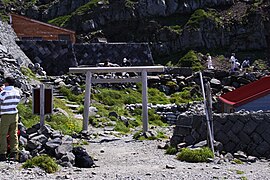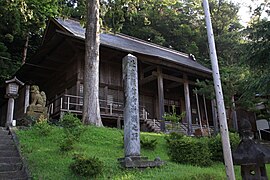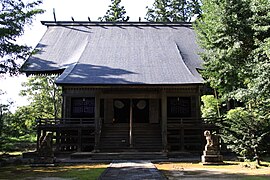Chōkaisan Ōmonoimi Shrine
You can help expand this article with text translated from the corresponding article in Japanese. (December 2023) Click [show] for important translation instructions.
|
| Chōkaisan Ōmonoimi Shrine | |
|---|---|
鳥海山大物忌神社 | |
 Altar of the shrine at the peak | |
| Religion | |
| Affiliation | Shinto |
| Deity | Omonoimi no Kami, Toyoukebime, and Tsukuyomi-no-Mikoto |
Chōkaisan Ōmonoimi Shrine (Japanese: 鳥海山大物忌神社), also known as Chokaisan Ōmonoimi-jinja, is a Shinto shrine on Mount Chokai in Yamagata Prefecture, Japan.[1][2][3][4] The shrine has three parts on different parts of the mountain: Fukura-kuchinomiya and Warabioka-kuchinomiya at the foot of the mountain and easier to access for visitors, and the main shrine – known as Sanchō-Gohonsha – on the mountain's summit.[5][6] The Shrine is a national historic site.[5]
The shrine is primarily dedicated to Omonoimi no Kami, the unique kami of the shrine,[5] but also worships Toyoukebime and Tsukuyomi-no-Mikoto.[7][8] Omonoimi no Kami is considered possibly identical to Toyouke-hime[a][9] who is also worshipped at the Warabioka subshrine.[7] Omonoimi no Kami is primarily associated with industrial growth and is also enshrined in other places in the Tōhoku region, including Chōkai gassan ryōsho-gu.[10]
The shrine directly worships the mountain as a Kannabi.[5][8][7] This is a rare practice and the only major shrines that continue the practice of direct Mountain Worship via Kannabi are Ōmiwa Shrine and Suwa-taisha and Kanasana Shrine.[11][12]
The shrine is the Dewa Province Ichinomiya, or the first ranked shrine of the Dewa Province.[5][13][14] It is close to the Three Mountains of Dewa which are also prominent spots of Mountain Worship.[13]
It is similar to Fujisan Hongū Sengen Taisha at Mount Fuji
History
[edit]The mountain has been worshipped since ancient times,[5] and its god Omonoimi no Kami has been identified with the mountain itself.[5][8][7]
Traditions vary about the founding of the main shrine with some saying during it was founded during the reign of Emperor Keikō and others saying it was founded during the reign of Emperor Kinmei.[5] The repeated destruction of the main shrine means archaeological evidence is difficult to find.
However the two shrines at the foot of the mountain are known to have been founded in 564 in the reign of Emperor Kinmei.[7]
Early mentions of the shrine include the Engishiki Jinmyocho where it is listed as a Myojin Taisha, a very highly ranked shrine and mentions in the Nihon Sandai Jitsuroku whjere an oracle foretold the Imperial Army's defeat in 878 and 879.[5]
In history every time the volcano erupted, the rank of Omonoimi no Kami was increased.[1] This meant more lands were given to the shrine and it became wealthier and more powerful.[15] Eruptions were interpreted as his anger.[16] Once it was said that a corpse was improperly disposed of near the mountain. At that point a massive eruption happened and dark muddy water flowed down the rivers which were dammed by dead fish.[17]
Omonoimi no Kami is known to have received the rank of Shōichii in the reign of Emperor Yōmei.[8]
The shrine has been a prominent place of shugendo since the Middle Ages.[5][18] A medieval buddhist myth of the temple says it was founded by the Buddhist monk En no Gyōja for "Chokai Daigongen".[19] This myth is most associated with Warabioka. Other myths involve other Buddhist monks like Ennin or Kūkai.
The shrine was subject to a legal battle after World War II because people were confused about who owned the summit with the end of State Shinto, as of 1966 the battle was still ongoing.[20] In 2008, the area from the summit to Kuchinomiya became a National Historic Site.[5]
Festivals
[edit]The shrine has a festival every year on July 14 called Hi-awase shinji (火合せ神事). During the festival all across Yamagata Prefecture fires are lit simultaneously at this shrine and other Omonoimi shrines including one in Sakata, Yamagata for good harvest and good fishing.[21]
Sanchō-Gohonsha
[edit]| Sanchō-Gohonsha | |
|---|---|
山頂御本社 | |
 Sanchō-Gohonsha | |
| Religion | |
| Affiliation | Shinto |
| Deity | Omonoimi no Kami |
| Location | |
| Geographic coordinates | 39°5′51.43″N 140°2′55.21″E / 39.0976194°N 140.0486694°E |
Sanchō-Gohonsha is the main shrine and it is located on the peak of Mount Chokai.[6] It looks like an ordinary cabin on the outside.[22] The shrine is rebuilt once every 20 years, it was rebuilt in 1997.[5]
Gallery
[edit]-
Very distant photo demonstrating the scale of the mountain
-
Birds eye view of the shrine complex
-
Torii
-
Torii from behind
-
Approaching the Honden
-
Mountain-top Main Shrine Honden
Fukura-kuchinomiya
[edit]| Fukura-kuchinomiya | |
|---|---|
吹浦口之宮 | |
 Fukura-kuchinomiya | |
| Religion | |
| Affiliation | Shinto |
| Deity | Tsukuyomi-no-Mikoto |
| Location | |
| Geographic coordinates | 39°04′30.45″N 139°52′44.05″E / 39.0751250°N 139.8789028°E |
Fukura-kuchinomiya is a subshrine located at the foot of the mountain.[6] It is located 15 km west of the main shrine and 10 km northwest of Warabioka-kuchinomiya
Local tradition says the shrine was founded by Ennin
The Honden is located on a hill and faces south.[7]
Tsukuyomi-no-Mikoto is enshrined here.
A lake called Maruikesama is worshipped nearby as a Kannabi. The lake is considered to be a Kami itself rather than merely one living in it.[b][23]
Gallery
[edit]-
Entrance Torii
-
Haiden
-
Honden
-
Honden from different angle
Warabioka-kuchinomiya
[edit]| Warabioka-kuchinomiya | |
|---|---|
蕨岡口之宮 | |
 Warabioka-kuchinomiya | |
| Religion | |
| Affiliation | Shinto |
| Deity | Toyoukebime, Ukanomitama |
| Location | |
| Geographic coordinates | 38°59′49.00″N 139°56′38.00″E / 38.9969444°N 139.9438889°E |
Warabioka-kuchinomiya is a subshrine located at the foot of the mountain.[6] It is located 10 km southeast of Fukura-kuchinomiya, and 14 km southwest of Sancho-Gohonsha. The shrine worships agricultural deities Toyoke-Ookami and Ukanomitama no Mikoto.[7]
It is said in local tradition that the legendary Buddhist monk En no Gyōja founded the shrine.[19]
The shrine has four small Hokora or subshrines of its own.[7]
There is a festival celebrated here on May 3 called Daimonbei Matsuri.[5]
There are three torii gates and the movie Rurouni Kenshin: The Legend Ends was filmed there.[24]
Gallery
[edit]-
First Torii
-
Second Torii
-
Third Torii
-
Honden
See also
[edit]- Fujisan Hongū Sengen Taisha
- Chōkai gassan ryōsho-gu
- Three Mountains of Dewa
- Other highly ranked shrines of Dewa Province
- Ninomiya Kinowa Shrine
- Sannomiya Omoimi Shrine
Notelist
[edit]- ^ Ōmonoimi-no-kami is believed to be the god of Mount Chōkai, or the northernmost post of the land of Yamato.
- ^ Lake coordinates: 39°4′22″N 139°53′30″E / 39.07278°N 139.89167°E
References
[edit]- ^ a b Fukada, Kyūya (2014-12-31). One Hundred Mountains of Japan. University of Hawaii Press. p. 76. ISBN 978-0-8248-4785-2.
- ^ Kōdansha (1983). Kodansha Encyclopedia of Japan. Kodansha. ISBN 978-0-87011-620-9.
- ^ "Climbing a less-crowded mountain in Japan". Stripes Okinawa. 2017-11-20. Retrieved 2023-10-26.
- ^ Engi-shiki; Procedures of the Engi Era: Books I-V. Sophia University. 1970.
- ^ a b c d e f g h i j k l m "chokaizan omonoimi shrine(warabioka kuchi no miya) - shrine-heritager". shrineheritager.com. Archived from the original on 2023-11-11. Retrieved 2023-04-25.
{{cite web}}: CS1 maint: unfit URL (link) - ^ a b c d "Chokaizan Omono-Imi Jinja - Must-See, Access, Hours & Price". GOOD LUCK TRIP. 6 June 2022. Retrieved 2023-04-25.
- ^ a b c d e f g h "Okunomichi". 28 August 2014. Archived from the original on 2014-10-14. Retrieved 2023-11-04.
- ^ a b c d Fukada, Kyūya (2014-12-31). One Hundred Mountains of Japan. University of Hawaii Press. p. 76. ISBN 978-0-8248-4785-2.
- ^ Sonoda, Minoru [in Japanese]; Mogi, Sakae (1997). Nihon no kamigami no jiten : Shinto saishi to yaoyorozu no kamigami. Books esoterica, 2.; New sight mook (in Japanese). Gakken. pp. 68, 69. ISBN 9784056016291. OCLC 42978057.
- ^ "Enshrined Gods". kawawajinja.com. Retrieved 2023-06-18.
- ^ Cali, Joseph; Dougill, John (2012). Shinto Shrines: A Guide to the Sacred Sites of Japan's Ancient Religion. Honolulu: University of Hawai'i Press. p. 195. ISBN 978-0-8248-3775-4.
- ^ "Keeping Ancient Mountain Worship Alive at Saitama's Kanasana Shrine". nippon.com. 2018-07-08. Retrieved 2023-10-18.
- ^ a b Suzuki, Masataka. "Dewasanzan Shinkō". Kokugakuin University Encyclopedia of Shinto.
- ^ "Nationwide List of Ichinomiya" (PDF). Archived from the original (PDF) on 2012-02-13. Retrieved 2023-12-01.
- ^ "Basic Terms of Shinto: Shinkai". www2.kokugakuin.ac.jp. Retrieved 2023-11-11.
- ^ Suzuki, Yui (2011-12-19). Medicine Master Buddha: The Iconic Worship of Yakushi in Heian Japan. BRILL. ISBN 978-90-04-22917-4.
- ^ Suzuki, Yui (2011-12-23). Medicine Master Buddha: The Iconic Worship of Yakushi in Heian Japan. BRILL. ISBN 978-90-04-19601-8.
- ^ Castiglioni, Andrea; Rambelli, Fabio; Roth, Carina, eds. (2020). Defining Shugendō. Bloomsbury Academic. p. 57. doi:10.5040/9781350179424. ISBN 978-1-350-17939-4.
- ^ a b "Chokai - Christopher E. Brennen". brennen.caltech.edu. Retrieved 2023-11-11.
- ^ "Reminiscences of Religion in Postwar Japan: Economic Changes after the War (Continued)". Contemporary Religions in Japan. 7 (1): 51–79. 1966. ISSN 0010-7557. JSTOR 30232985.
- ^ Mogi, Sakae. "Hi-awase shinji". Kokugakuin University Encyclopedia of Shinto. Archived from the original on 2023-04-25. Retrieved 2023-04-25.
- ^ https://archive.today/20230425185131/https://akitajet.com/wiki/Mount_Ch%C5%8Dkai
- ^ "Maruikesama" (PDF). Archived from the original (PDF) on 2022-05-02. Retrieved 2023-11-04.
- ^ "Warabioka Kuchinomiya Shrine". Guidoor. Retrieved 2023-04-25.














